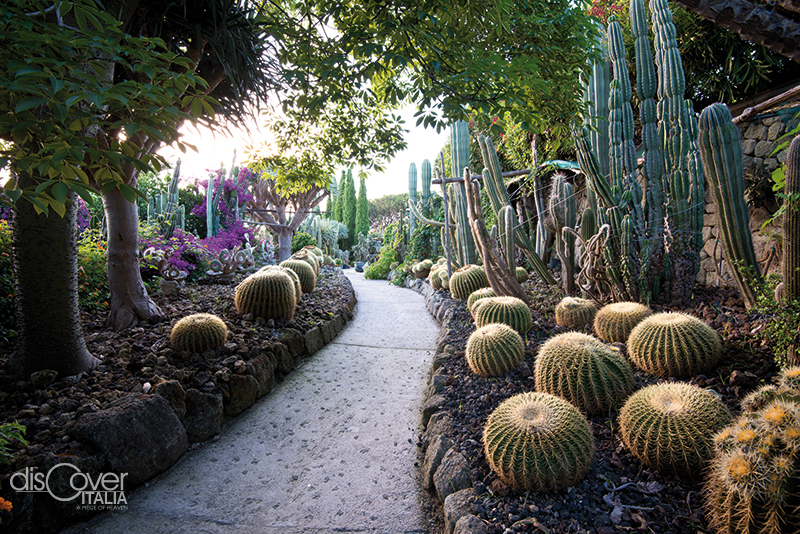At the Ravino Gardens in Forio d'Ischia the largest collection of succulent plants in Europe.
An ancient vineyard facing west, in front of the wonder of the sunset that is renewed every day in the sea of Forio d’Ischia. A fertile land, whichs welcomes and feeds even strangers, as if they have always belonged to it. A climate that does not betray and that with its mildness makes the difference. And a great passion that time has not affected, but has helped to materialise. The Ravino Gardens are a happy and successful combination of all these elements. In fact, 400 species of plants from the five continents grow there, luxuriant as if they were still in their homeland. Mostly tropical "succulent" plants, but also a wide representation of Mediterranean flora, respecting the specificity of the island, which is safeguarded and even enhanced by the harmonious sharing of spaces with the numerous and prevalent invasive species.
Passion came first. The one of Captain Giuseppe D'Ambra, who in his business trips around the world began to become passionate about the "succulent" plants he saw in his different landings since the 1960s. And soon, in addition to admiring them in their places of origin, he began to collect them, each time bringing something new on his return home to the island. Where the new arrivals, although taking advantage of the attention reserved for them by the captain, who became a great expert from self-taught, showed that they found a suitable context not only to survive, but to bear fruit, to reproduce and to reach considerable dimensions, not different from those of many areas of origin. Another but not obvious demonstration of the "versality" of Ischia's environment, which over the millenia has managed to make it own plants of different characteristics and from the most varied origins.
The result of many careful acquisitions and selections, D'Ambra had accumulated a unique green heritage on the roof of Villa Ravino: three thousand examples of "succulent" plants in constant growth and evolution. In 2000, a 6 000 square meter vineyard was put up for sale in front of the villa. An opportunity not to be missed to arrange the collections on the roof no longer temporarily. After years of work, the inauguration of the Gardens took place in 2005 to transfer the thousands of specimens to the open ground in the most suitable conditions. Finally, the creature long imagined and prepared by the captain with the support and contribution of his wife Edith, his sons and daughters-in-law had come to light. A family commitment that did not end then, but that has always faced new challenges over the years, to implement the garden and to make it an example of eco-sustainability and green culture in the area.
Botanical park of acclimatisation, the Ravino Gardens house the largest and most varied collection of succulent plants in Europe. A spectacular mix of shapes, colors, dimensions and origins that remembers the spirit of a botanical garden and that transforms the visit to the garden into an ideal journey, concentrated in time and space, to a multiplicity of habitats distributed in the most diverse regions of the planet . The presence of cacti is extraordinary, giving generous blooms and edible fruit. There are columnar Cereus, Globose Echinocactus, Cylindrical Ferocacatus, Climbing Selenicereus, Hanging Aporocactus, Creeping Stenocereus, Fluff-covered Espostoa, Pachipodiumand Pereskie, the only species with leaves. And also: Sedum, Sempervivum, Crassule, Calanchoe, Agaves, Aloe, Palms, Zamie, Macrozamie, Chorisia, Nolina, Ciphostemma. The original collection has been enriched with large specimens of the saguaros that populate the red desert of Arizona, of grusoni, better known as "mother-in-law's seats" full of spines, of Cycadeae and Musaceae. And then the coffee, tea, soap, kapok and sugar cane plants.
Tropical plants that live in harmony, even visually, with the native plants of the Mediterranean scrub, with the highly fragrant aromatic plants, with the water lilies of the watercourse that flows in the garden, with damask roses and fragrant pelargoniums, and with dozens of citrus fruits. And a collection of bonsai, the protagonist of courses for the passionate ones.
But among all these botanical peculiarities there is one even more special than the others. A green fossil, even from the Jurassic period, the Wollemia nobilis which was considered extinct until 1994, when a station was found in the Wollemi National Park of the Blue Mountains of New South Wales in Australia. Two specimens of that unique species of tall trees, close to conifers but which are not, are found in the Ravino Gardens. Where the singing of the birds that live on the island is joined by the shrill cries of the peacocks running free, with the male who often shows its splendid multicolored tail. And then the free rabbits and the Tibetan goat and the parrots.
In the rooms belonging to the ancient vineyard, spaces for welcoming visitors have been created. In particular, the Cactus Lounge Café, where you can try the products of the organic garden of the house and the famous cactus cocktail with always different cactus seeds and fruits depending on the season, passionflower juice, the four types of mint of the Gardens and, in the alcoholic version, of tequila. In the ancient cistern, then, the Moby Dick room was found, where exhibitions, conferences and cultural events succeed during the summer.
"Opening a botanical garden was my dream come true - Captain D'Ambra likes to repeat - The passions pursued always pay off". Not only him, but also the visitors of his amazing creation.
Information
The garden is open on Mondays, Wednesdays, Fridays, Saturdays and Sundays from 10 a.m. to 6 p.m.
Full price ticket: 10€
Reduced ticket: 5€





Comments powered by CComment